|
|
|
Sort Order |
|
|
|
Items / Page
|
|
|
|
|
|
|
| Srl | Item |
| 1 |
ID:
165137
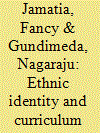

|
|
|
|
|
| Summary/Abstract |
The paper aims to understand the role of school textbooks and curriculum in shaping the majority and minority identity in Tripura. Though Tripura is a tribal majority state, the partition of the country led to the influx of Bengali Hindus. Based on the sociological analysis of history and language textbooks in Tripura schools, the paper argues that the state is systematically projecting the Bengali Hindu identity as ideal and marginalising the identity of diverse tribal groups. Dominant language, religion and cultural practices of the Bengalis were celebrated whereas the linguistic diversity and spiritual pathways of the subaltern communities are either ignored or mentioned peripherally. Since the inception of formal education in Tripura, the state failed to develop the tribal languages and script which led to the ideological submission of ethnic groups to the dominant identity. Thus, Tripura witnessed an ideological shift from the multiple identities to monolithic identity works on the principle of Banglanization of the state and civil society.
|
|
|
|
|
|
|
|
|
|
|
|
|
|
|
|
| 2 |
ID:
187286
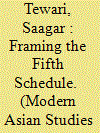

|
|
|
|
|
| Summary/Abstract |
As a means to resolve the Tribal Question in India, the centrality of the Fifth and Sixth Schedules of the Indian Constitution is widely acknowledged. However, their final incorporation, despite intense nationalist opposition in the run-up to Indian Independence, remains historically unexplained. This article addresses this lacuna by reconstructing the circumstances under which the Indian National Congress came to accept scheduling as a viable method of providing protection to tribal communities. This strategic shift can be explained as a result of combined political pressures generated by communist-led tribal movements and a steadily mounting challenge heralded by a new stream of educated middle-class tribal activists in eastern India. Foremost among the latter was Jaipal Singh Munda who mobilized a large constituency of supporters demanding a separate province of Jharkhand. Taken together, there is enough evidence to prove that in the period 1937–1950, the tribes were not silent and their collective agency had a deep impact on the constitution-making process. Finally, the article argues that this period witnessed a significant change in the character of the Congress as erstwhile freedom-fighters turned into ruling elites.
|
|
|
|
|
|
|
|
|
|
|
|
|
|
|
|
| 3 |
ID:
165004
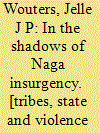

|
|
|
|
|
| Publication |
New Delhi, Oxford University Press, 2018.
|
| Description |
xxiv, 329p.: figureshbk
|
| Standard Number |
9780199485703
|
|
|
|
|
|
|
|
|
|
|
|
Copies: C:1/I:0,R:0,Q:0
Circulation
| Accession# | Call# | Current Location | Status | Policy | Location |
| 059625 | 303.60954165/WOU 059625 | Main | On Shelf | General | |
|
|
|
|
| 4 |
ID:
187280
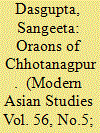

|
|
|
|
|
| Summary/Abstract |
This article explores nineteenth-century colonial representations of the Oraons of Chhotanagpur. Described in administrative reports of early nineteenth-century Chhotanagpur as mlecchha and dhangar, or as part of a ‘village community’ of Coles/Kols, these Oraons, by the late nineteenth century, were referred to as a ‘tribe’. To trace the categories through which the Oraons journeyed across colonial records, I discuss texts and reports which later became part of bureaucratic memory. The shifts within official understanding, I argue, were related to the working of official minds, changing assumptions, and differing languages; the tensions within the discipline of anthropology and its application in the colony; the variations within ideologies of governance and the imperatives of rule; and interactions with ‘native’ informants and correspondents, along with personal observations of local practices. There remained, however, an uneasy tension between wider intellectual trends in Europe and their reverberations in the colony, and the experiences of governance: colonial knowledge was not always produced with arrogance and assurance but also with doses of uncertainty, hesitation, disquiet, and often despair. In the shifting representations of the tribe across the nineteenth century, there is, I suggest, a pattern. In the pre-1850s, local nomenclature was adopted and voices of dissent—expressed through agrarian protests in Chhotanagpur—were addressed. By the 1850s, the utilitarian agenda structured colonial imaginaries and interventions. The 1860s witnessed the interplay of ethnological concerns, missionary beliefs, and Arcadian principles. From the 1890s, the idea of tribe was overwhelmingly structured by the supremacy of disciplinary knowledge systems that increasingly supplanted the role of the ‘native’ informant.
|
|
|
|
|
|
|
|
|
|
|
|
|
|
|
|
| 5 |
ID:
173840


|
|
|
|
|
| Summary/Abstract |
In 2009, Major Jim Gant published a treatise online entitled One Tribe at a Time, outlining a strategy for victory in Afghanistan based on the still untested counterinsurgency doctrine developed by General David Petraeus. Gant was given the opportunity to put theory to the test by returning to the village of Mangwal in eastern Kunar Province. Evaluation of Gant’s mission has been overshadowed by the scandal that led to his resignation from the US Special Forces. This essay provides a re-examination of Gant’s time in Mangwal based on interviews with residents of Mangwal and an appraisal of the lessons that can be learned from Gant’s attempt to put counterinsurgency principles into practice.
|
|
|
|
|
|
|
|
|
|
|
|
|
|
|
|
| 6 |
ID:
143209
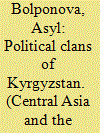

|
|
|
|
|
| Summary/Abstract |
The author traces the history of the clan system and its evolution as part of the political processes unfolding in Kyrgyzstan. She relies on facts to demonstrate that the clan system of our days is a product of classical unification of tribes into clans.
|
|
|
|
|
|
|
|
|
|
|
|
|
|
|
|
| 7 |
ID:
168818
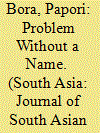

|
|
|
|
|
| Summary/Abstract |
This paper is about race and race relations in India with a focus on the experiences of violence and discrimination that people from India’s Northeast face in mainland India. This has become a ‘problem without a name’, generally articulated as a problem of cultural difference. The paper argues that the emphasis on cultural difference elides the issue of racism faced by India’s north-eastern subjects, whereby culture is a mere substitute for race. Institutional approaches to racism tend to rely on a biological understanding of race. The paper demonstrates the racial formation of the category ‘north-eastern’ through the processes of colonialism, nationalism and counter-insurgency. This approach shows the ways in which racism, classism and sexism work together in constituting the racialised, gendered and classed north-eastern subject.
|
|
|
|
|
|
|
|
|
|
|
|
|
|
|
|
| 8 |
ID:
174793


|
|
|
|
|
| Summary/Abstract |
Northeast India, a ‘zipper region’ that gives impetus to Southeast Asian and Himalasian studies, is marked by complexities and ambiguities. The paper examines the multiple identity construction in contemporary Assam, the central state of this region and seeks to recover the other experiences that make ethnic life-world possible while challenging the ethnocentric discourses—in academia, politics, public and social movements. Acknowledging the presence of common or possibly universal processes behind the production of such discourses, it aims to interrogate the factors that cut across socio-cultural, political-economical or ecological dimensions. It further examines the multiple discourses and narratives that makes that social possible in the region. In doing so, it locates the strategic positioning of such discourses and how they deal with Indian nation-state and beyond. This paper in essence is interested in the question of possibility of various discourses—as a question of post-history.
|
|
|
|
|
|
|
|
|
|
|
|
|
|
|
|
| 9 |
ID:
126658
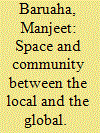

|
|
|
|
|
| Publication |
2013.
|
| Summary/Abstract |
The objective of this article is to situate the relation between the local and the global in the context of a specific region formation, namely the Brahmaputra Valley of Assam in India as a frontier. The article takes up two examples on the relation between space and community construct and how the relation forms part of the deeper relation between the local and the global in the Valley. The Brahmaputra Valley comprises the major area of the Indian state of Assam. Assam and its neighbouring areas are also referred to as 'North East India'. The term came into use during the colonial period. It was used to refer to the British-Indian frontier which bordered on Bhutan, Tibet, China and Myanmar. In the first example of the article, the local-global relation is seen in terms of how the colonial-capitalism paradigm altered the pre-colonial socio-spatial relation, formulating and implementing new spatial and social classifications. The focus in the example is on the rearrangement of socio-spatial relations in the Valley as part of transforming a pre-colonial crossroads into a colonial frontier. In the second example, the relation between space and community construct is situated in popular responses to the above changes, and especially how international ideology like communism is appropriated to address the local specificity of frontier. The works of the cultural icon and peasant leader of the Valley, Bishnu Rabha, are discussed in detail. Through the interrelation between the two examples, the article tries to show how between the nineteenth and the mid-twentieth century the local specificity of the Valley as a frontier was possible precisely due to changes of state formation or ideology which drew on a global context. In other words, the relation between space and community construct in the Valley demonstrates how the coexistence of the local and the global was a necessary condition in its making as a frontier. Community constructs like 'tribe', 'Assamese' and 'Ahom' during the period formed part of this interrelation between the local and the global that
|
|
|
|
|
|
|
|
|
|
|
|
|
|
|
|
| 10 |
ID:
100893
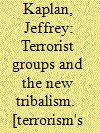

|
|
|
|
|
| Publication |
London, Routledge, 2010.
|
| Description |
235p.
|
| Series |
Political violence series
|
| Standard Number |
9780415453387, hbk
|
|
|
|
|
|
|
|
|
|
|
|
Copies: C:1/I:0,R:0,Q:0
Circulation
| Accession# | Call# | Current Location | Status | Policy | Location |
| 055544 | 363.325/KAP 055544 | Main | On Shelf | General | |
|
|
|
|
| 11 |
ID:
164912
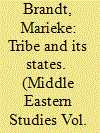

|
|
|
|
|
| Summary/Abstract |
Across the Middle East, tribes and states have entered into different relationships. In many countries, tribes were confronted with massive attempts at interference by their respective states. The northern Yemeni Republic, in contrast, remained a weak state with little coercive instruments at its disposal. Its rule was rather based on indirect means: the politics of patronage, the politicization of development efforts, and the exploitation of tribal conflict. This article aims to look closer into state-tribe relations in Yemen by reviewing the power struggle between the Khawlan al-Tiyal tribe and the republican government. In 1972, the regional ramifications of this struggle culminated in the so-called ‘Bayhan massacre’ whose legacy continues to resonate across tribal Yemen today. The Khawlan case gives evidence of how power and legitimacy in republican Yemen remained, and still remain, largely contingent on the politics of co-optation and patronage, an endemic feature that comes at the expense of real institution building.
|
|
|
|
|
|
|
|
|
|
|
|
|
|
|
|
| 12 |
ID:
184809
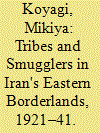

|
|
|
|
|
| Summary/Abstract |
Based primarily on British consular reports, this article studies transborder movement in Iran's eastern borderlands during the two decades following the rise of Reza Khan in 1921. It discusses two kinds of transborder movements: tribal exodus and smuggling. By examining the contexts of these transborder movements, this article explores the desire of the new state to assert sovereignty as it appeared in the borderlands and demonstrates that, rather than simply closing the borders, the Pahlavi state attempted to control the flows of people and goods, with dual effects. It introduced new constraints to mobility and as well fostered the development of borderland networks that enabled diffused transborder movement, making it harder for the authorities to control.
|
|
|
|
|
|
|
|
|
|
|
|
|
|
|
|
|
|
|
|
|